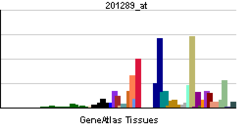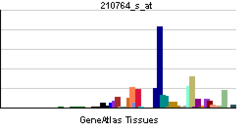- CYR61
-
Protein CYR61 is a protein that in humans is encoded by the CYR61 gene.[1]
CYR61 is a secreted, cysteine-rich, heparin-binding protein encoded by a growth factor-inducible immediate-early gene. Acting as an extracellular, matrix-associated signaling molecule, CYR61 promotes the adhesion of endothelial cells through interaction with integrin and augments growth factor-induced DNA synthesis in the same cell type.[supplied by OMIM][2]
References
- ^ Jay P, Berge-Lefranc JL, Marsollier C, Mejean C, Taviaux S, Berta P (May 1997). "The human growth factor-inducible immediate early gene, CYR61, maps to chromosome 1p". Oncogene 14 (14): 1753–7. doi:10.1038/sj.onc.1200986. PMID 9135077.
- ^ "Entrez Gene: CYR61 cysteine-rich, angiogenic inducer, 61". http://www.ncbi.nlm.nih.gov/sites/entrez?Db=gene&Cmd=ShowDetailView&TermToSearch=3491.
Further reading
- Maruyama K, Sugano S (1994). "Oligo-capping: a simple method to replace the cap structure of eukaryotic mRNAs with oligoribonucleotides.". Gene 138 (1–2): 171–4. doi:10.1016/0378-1119(94)90802-8. PMID 8125298.
- Genini M, Schwalbe P, Scholl FA, Schäfer BW (1996). "Isolation of genes differentially expressed in human primary myoblasts and embryonal rhabdomyosarcoma". Int. J. Cancer 66 (4): 571–7. doi:10.1002/(SICI)1097-0215(19960516)66:4<571::AID-IJC24>3.0.CO;2-9. PMID 8635876.
- Suzuki Y, Yoshitomo-Nakagawa K, Maruyama K, et al. (1997). "Construction and characterization of a full length-enriched and a 5'-end-enriched cDNA library". Gene 200 (1–2): 149–56. doi:10.1016/S0378-1119(97)00411-3. PMID 9373149.
- Kireeva ML, Lam SC, Lau LF (1998). "Adhesion of human umbilical vein endothelial cells to the immediate-early gene product Cyr61 is mediated through integrin alphavbeta3". J. Biol. Chem. 273 (5): 3090–6. doi:10.1074/jbc.273.5.3090. PMID 9446626.
- Kolesnikova TV, Lau LF (1998). "Human CYR61-mediated enhancement of bFGF-induced DNA synthesis in human umbilical vein endothelial cells". Oncogene 16 (6): 747–54. doi:10.1038/sj.onc.1201572. PMID 9488038.
- Schütze N, Lechner A, Groll C, et al. (1998). "The human analog of murine cystein rich protein 61 [correction of 16] is a 1alpha,25-dihydroxyvitamin D3 responsive immediate early gene in human fetal osteoblasts: regulation by cytokines, growth factors, and serum". Endocrinology 139 (4): 1761–70. doi:10.1210/en.139.4.1761. PMID 9528960.
- Martinerie C, Viegas-Pequignot E, Nguyen VC, Perbal B (1998). "Chromosomal mapping and expression of the human cyr61 gene in tumour cells from the nervous system". MP, Mol. Pathol. 50 (6): 310–6. doi:10.1136/mp.50.6.310. PMC 379665. PMID 9536281. http://www.pubmedcentral.nih.gov/articlerender.fcgi?tool=pmcentrez&artid=379665.
- Babic AM, Kireeva ML, Kolesnikova TV, Lau LF (1998). "CYR61, a product of a growth factor-inducible immediate early gene, promotes angiogenesis and tumor growth". Proc. Natl. Acad. Sci. U.S.A. 95 (11): 6355–60. doi:10.1073/pnas.95.11.6355. PMC 27701. PMID 9600969. http://www.pubmedcentral.nih.gov/articlerender.fcgi?tool=pmcentrez&artid=27701.
- Jedsadayanmata A, Chen CC, Kireeva ML, et al. (1999). "Activation-dependent adhesion of human platelets to Cyr61 and Fisp12/mouse connective tissue growth factor is mediated through integrin alpha(IIb)beta(3)". J. Biol. Chem. 274 (34): 24321–7. doi:10.1074/jbc.274.34.24321. PMID 10446209.
- Chen N, Chen CC, Lau LF (2000). "Adhesion of human skin fibroblasts to Cyr61 is mediated through integrin alpha 6beta 1 and cell surface heparan sulfate proteoglycans". J. Biol. Chem. 275 (32): 24953–61. doi:10.1074/jbc.M003040200. PMID 10821835.
- Albrecht C, von Der Kammer H, Mayhaus M, et al. (2000). "Muscarinic acetylcholine receptors induce the expression of the immediate early growth regulatory gene CYR61". J. Biol. Chem. 275 (37): 28929–36. doi:10.1074/jbc.M003053200. PMID 10852911.
- Chen CC, Chen N, Lau LF (2001). "The angiogenic factors Cyr61 and connective tissue growth factor induce adhesive signaling in primary human skin fibroblasts". J. Biol. Chem. 276 (13): 10443–52. doi:10.1074/jbc.M008087200. PMID 11120741.
- Grzeszkiewicz TM, Kirschling DJ, Chen N, Lau LF (2001). "CYR61 stimulates human skin fibroblast migration through Integrin alpha vbeta 5 and enhances mitogenesis through integrin alpha vbeta 3, independent of its carboxyl-terminal domain". J. Biol. Chem. 276 (24): 21943–50. doi:10.1074/jbc.M100978200. PMID 11287419.
- Chen CC, Mo FE, Lau LF (2002). "The angiogenic factor Cyr61 activates a genetic program for wound healing in human skin fibroblasts". J. Biol. Chem. 276 (50): 47329–37. doi:10.1074/jbc.M107666200. PMID 11584015.
- Tamura I, Rosenbloom J, Macarak E, Chaqour B (2001). "Regulation of Cyr61 gene expression by mechanical stretch through multiple signaling pathways". Am. J. Physiol., Cell Physiol. 281 (5): C1524–32. PMID 11600415.
- Xie D, Nakachi K, Wang H, et al. (2002). "Elevated levels of connective tissue growth factor, WISP-1, and CYR61 in primary breast cancers associated with more advanced features". Cancer Res. 61 (24): 8917–23. PMID 11751417.
- Leng E, Malcolm T, Tai G, et al. (2002). "Organization and expression of the Cyr61 gene in normal human fibroblasts". J. Biomed. Sci. 9 (1): 59–67. PMID 11810026.
- Tsai MS, Bogart DF, Li P, et al. (2002). "Expression and regulation of Cyr61 in human breast cancer cell lines". Oncogene 21 (6): 964–73. doi:10.1038/sj.onc.1205131. PMID 11840342.
- Schober JM, Chen N, Grzeszkiewicz TM, et al. (2002). "Identification of integrin alpha(M)beta(2) as an adhesion receptor on peripheral blood monocytes for Cyr61 (CCN1) and connective tissue growth factor (CCN2): immediate-early gene products expressed in atherosclerotic lesions". Blood 99 (12): 4457–65. doi:10.1182/blood.V99.12.4457. PMID 12036876.
Categories:- Human proteins
- Chromosome 1 gene stubs
Wikimedia Foundation. 2010.


